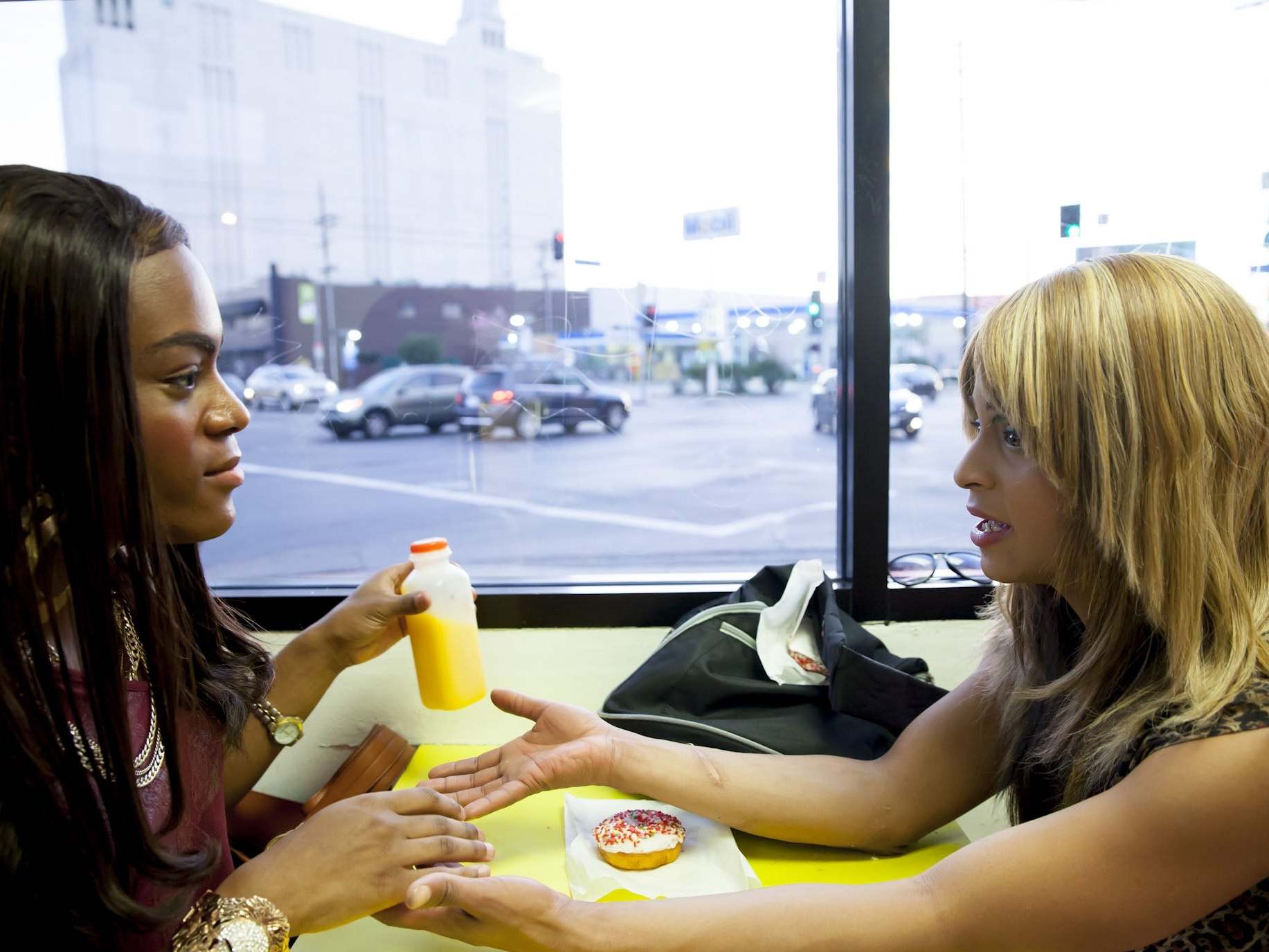In Tangerine’s tale of trans sex workers, hope and despair go hand in hand
Hollywood, for decades, has depicted the trans sex worker as a tragic victim or crass punchline. As Clarisse Loughrey writes, ‘Tangerine’ is the vital reality check


In Tangerine, the camera zips down LA’s streets like a curious fly. It circles pedestrians in tight, aerial loops. It dives in so close to their faces that, at any moment, it feels like a hand might reach out and swat it away. There are many souls to follow here, as they pace up and down sidewalks, each on their own private odyssey. Tangerine chooses to tail two trans sex workers, Sin-Dee (Kitana Kiki Rodriguez) and Alexandra (Mya Taylor), who we first meet over a celebratory doughnut.
Sin-Dee, fresh from a month-long stint in prison for drug possession, discovers that her boyfriend-slash-pimp Chester (James Ransone) has been unfaithful – worst of all, with a “fish” (a cisgender woman). Her name is Dana or Desiree or Dinah. The name definitely starts with a D. Sin-Dee heads out on the warpath, with a nervous Alexandra in tow. Occasionally, the camera will turn its attention to Razmik (Karren Karagulian), an Armenian cab driver and one of Alexandra’s regular clients. Today is Christmas Eve. Family duty calls him home, but his mind keeps drifting elsewhere.
At its 2015 premiere at the Sundance Film Festival, Tangerine was treated as something of a modern marvel – it turned out director Sean Baker had shot the entire film on three iPhone 5S handsets. He wasn’t the first to swap cameras for smartphones, but he was certainly the most innovative. With only a handful of accessories – an anamorphic lens, Steadicam, and $8 app called Filmic Pro – he still found a way to capture the city in all its sensuous, chaotic glory. In post-production, he ignored social-realism’s love of muted colours and turned his LA into a sun-baked terrarium. When orange came to dominate the colour palette, the film’s title was born.
Critics lapped up Baker’s punkish, experimental tone. Geoffrey Macnab, in The Independent, praised its “extraordinary visual inventiveness, humour and pathos”. The Guardian’s Peter Bradshaw ascribed to it “an anarchic sort of New Wave looseness”. Audiences weren’t quite as enthusiastic, but the film still gained enough traction to see an Oscar campaign launched on behalf of its leads, Taylor and Rodriguez. It was the first time trans actors had ever been given an awards season push. But Hollywood, it would seem, would much rather bleat on about how “brave” cis actors are for taking on trans roles. Tangerine’s leads weren’t nominated, but Eddie Redmayne was, for playing trans icon Lili Elbe in The Danish Girl. It’s a barrier we’ve yet to break.
Tangerine is, undoubtedly, much more than its media narrative – a work of immense compassion, tenderness, and verve. Baker’s choice to shoot on the iPhone was, initially, a matter of necessity. His budget was half that of his previous feature, 2012’s Starlet, which itself was shot for only $235,000. But it’s a compromise that, consciously or not, put his film within the wider context of social media. This is a story told using the tools most familiar to its own characters. It plays at times like a glossy, feature-length Vine or Instagram Live, with Baker casting several influencers in key supporting roles. There is an immediacy to it – a kind of ground-level authenticity.
The iPhone also allowed Baker to indulge in some light subterfuge. Scenes could be staged out in public without altering passers-by to the artifice of what they were witnessing – at one point, a bus driver called the cops after mistaking a filmed confrontation for the real thing. His cast, made up largely of first-time actors, didn’t feel intimidated when faced with the same machine they had in their own pockets. They felt free to experiment and improvise.
It may seem odd to praise the authenticity of a film about the experiences of two black, trans sex workers directed by a white, cis man, but Baker has always been upfront about the limitations of his own perspective. His approach is not to rely on an imperfect imagination, but to immerse himself within the communities he seeks to depict – it’s as true here as it was for his depiction of wealth inequality in 2017’s Florida Project. He is as interested in other people’s truths as he is the possibilities of cinema.
He knew only that he wanted to make a film about Donut Time, a local curio in his neighbourhood of Santa Monica and Highland. And so, he and co-writer Chris Bergoch just started talking to people. He met Taylor, a singer, in the courtyard outside the local LGBT+ centre. The area was popular with trans sex workers and Taylor had friends in the industry whose stories she could share. She then introduced the director to Rodriguez, who worked as a health educator. They make for a brilliant onscreen odd couple – Alexandra works hard to be the anchor, while Sin-Dee lives to be the tempest.
Almost every incident in Tangerine is drawn from the stories Taylor and Rodriguez had picked up over the years. The vernacular is theirs, too. But, though the film has all the wild energy of a piece of secondhand gossip, it’s punctuated by the constant, quiet thrum of fear – that a client will hurt them, the cops will throw them in jail, or society’s rampant transphobia will kill them.
Hollywood, for decades, has depicted the trans sex worker (and especially the black trans sex worker) as a tragic victim or crass punchline. Tangerine is the vital reality check. Taylor, in the past, has spoken about how the dire lack of employment opportunities for trans individuals (she applied for 186 jobs in one month and didn’t get a single one) leaves many with little option but to go into sex work.
Hope and despair go hand in hand in Tangerine. But, long after the credits roll, it’s the small, sweet acts of kindness that linger. The sight of a wig, quietly passed between two women, becomes an act of pure, unconditional love – a reminder that no battle should be fought alone.
Join our commenting forum
Join thought-provoking conversations, follow other Independent readers and see their replies
Comments